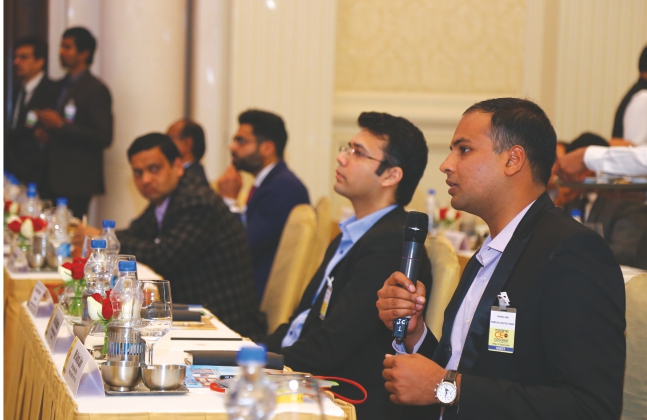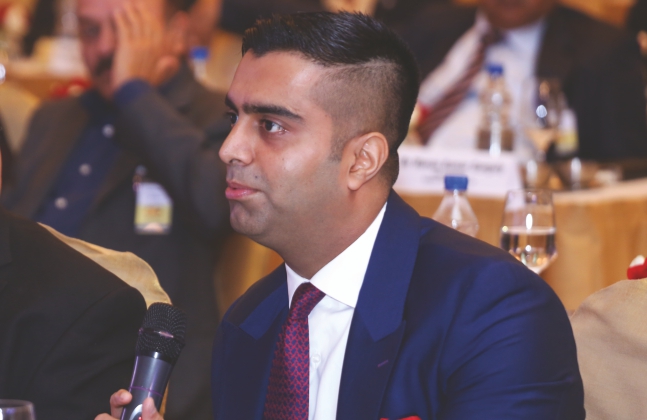V Kalyana Rama, CMD, CONCOR and Manish Puri, Managing Director, APL India Linx, discuss in detail the cascading effect Direct Port Delivery will have on the supply chain and exports, especially when the share of DPD is going up at major ports. The discussion also touched upon infrastructure capacity and whether regulations are a boon or bane for the sector
When V Kalyana Rama, CMD, CONCOR and Manish Puri, Managing Director, APL India Linx share the dais, the discussion is bound to be interesting and this is what happened at the Maritime CEO Conclave as an enthralled audience witnessed a very engaging discussion presented by the dignitaries that touched several hot topics such as Direct Port Delivery, infrastructure capacity and regulations.
Manish Puri: The concept of Direct Port Delivery is actually breaking the supply chain, so are there any negative impacts that we should be looking at?
Kalyana Rama: DPD is a concept wherein we are trying to reinvent the cycle. When the ports started functioning there were no CFS and ICD as clearances were done in the port. The idea behind DPD as I understand is a just-in-time concept brought in to reduce the logistics cost. Maybe stopping unnecessary detention of cargo is one of the aims in DPD but the main aspect we have to see is the infrastructure availability.
As we are creating facilities and many facilities that are nominated as CFS or ICDs which function as processing centres for handling containers do not have adequate infrastructure.
As a result the entire supply chain is getting affected. But if we are able to create facilities with proper warehousing and other essential infrastructure, then whether the cargo is cleared at the port or the hinterland the supply chain will continue to flow through these facilities only. I don’t think the manufacturing or processing units will try to have their own infrastructure for doing the logistics. “Logistics has matured a lot in India, but we still have a long way to go to consider our 3PL logistics actually efficient.”
“If we look at the current scenario in India there are no 3PL industrial goods as it is mostly covered in courier cargo. The sector is waiting to be explored and there is good investment opportunity if the ICDs function as real logistics centres for the support of manufacturing, assembling and processing operations, with proper distribution mechanism.”
Manish Puri: What happens with DPD is that containers destined to one hinterland location, once they are cleared at the port the lines following their global practices want their container to be turned around at the port itself. We face the risk that containers which are meant to come to the hinterland, for getting returned at the port itself need to be de-stuffed at the port, the empties are handed over to the shipping lines and the cargo then reaches the hinterland in a different container. The cost and efficiency parameter of doing this cargo transhipment needs to be considered?
The second issue is that as the empty inventory starts going back from the ports, one of our objectives to increase our exports will be a problem because if we don’t get inventory in the hinterland then you will have to pay for moving empty containers from the port to the hinterland for the export cargo, could that be a possible negative impact?

“IF WE LOOK AT THE CURRENT SCENARIO IN INDIA THERE ARE NO 3PL INDUSTRIAL GOODS AS IT IS MOSTLY COVERED IN COURIER CARGO. THE SECTOR IS WAITING TO BE EXPLORED AND THERE IS GOOD INVESTMENT OPPORTUNITY IF THE ICDS FUNCTION AS REAL LOGISTICS CENTRES FOR THE SUPPORT OF MANUFACTURING, ASSEMBLING AND PROCESSING OPERATIONS, WITH PROPER DISTRIBUTION MECHANISM.”
V Kalyana Rama
CMD, CONCOR
Kalyana Rama: The scenario you have just mentioned is about shipping lines trying to optimise their inventory and they may use this opportunity (DPD) to make the customer collect their cargo at the port itself. But again it depends on the nature of cargo and the logistics cycle the customer wants to follow. If more customers desire to collect cargo at the port then the system will work well, but I think it’s not happening that way because ultimately the entire cost of operation when it is done in the holistic manner, even bringing container to the doorstep is benefiting the customers. After DPD has been introduced in the past two years in India, practically what we have seen is there is not much impact on the hinterland cargo movement, except where the shipping lines are trying to outweigh the customer.
Manish Puri: One of the members from the Customs had hinted about the possibility of more regulations coming in across stakeholders. More regulations can be good and bad – focusing on both positive and negative aspects of regulations, in certain cases regulation is required because there are activities that need to be controlled and at the end of the day all of us survive on the customer and if the customer is charged more than what he should be then there is a need for regulation. But at the same time the big regulator of our times “TAMP” has shown that there have been a whole series of problems with regulators regulating private business. What will be your view on more v/s less regulation for logistics activity and especially with respect to the hinterland cargo movement?
Kalyana Rama: Regulation is booth good and bad. Too much of regulation will again lead to license raj, while the customer stands to be outweighed if there are no regulations. Regulation only to ensure smooth conduct of business is facilitation. For instance, e-sealing of containers, RFID tags and KYCL (Know Your Container Location) service that has been implemented across the country at CONCOR facilities for providing complete visibility of cargo to customers at their desktop. “We are working towards developing applications using which customers should be able to clear their cargo without the need to visit CONCOR office. Here regulations need to be in place because if CONCOR raises its charges in an unfair manner for the services offered then it results in customer exploitation.” Self-regulation is the best regulation, but in the effort to maximise profits people do not follow it. But in the current scenario, government will not regulate for the sake of regulation, rather it will be a facilitation.
For instance, in the case of e-sealing of containers the regulation acts more as a facilitator. Even CONCOR is making necessary arrangement to provide e-seals to all its customers.
Manish Puri: The next issue is of matching demand and supply. On one hand we have a situation where excess capacity has been created in certain places – it can be at terminals or ports. On the other hand we also have a shortage of capacity in terms of infrastructure and availability of rakes. Are we facing excess capacity or are we still short of infrastructure?
Kalyana Rama: “Any infrastructure facility that we are creating for logistics should not be used beyond 80 per cent. If the usage goes beyond 80 per cent it leads to congestion and inefficiency.” But we also have certain excess capacity, particularly towards the hinterland in ICDs, but in certain pockets only, while certain areas again remain neglected. People are concentrating more on some markets like the NCR region, expecting them to be very lucrative. But the realisation in NCR is very less than some other parts of the country. CONCOR operates in 74 locations and I find that some of the NCR locations are not as good as the hinterland locations. This calls for an analysis of the market to find out why logistics providers are mostly concentrating on a particular region?

interacting with the panelists
Coming to the railways part, the main problem in India today is network congestion. To ease the network Indian Railways have planned around `800,000 crores for commissioning of DFCs. What we are ultimately looking at is the transit assurance and continuous cargo visibility. While visibility can be provided by any service provider but transit assurance has to come from Indian Railways.
Again there is congestion on the roads. With transit assurance the capacity constraint will be resolved and the adequate use of infrastructure such as loading stock will happen. And further, this will also help in proper utilisation of the excess capacity created in the hinterland, as transit assurance will encourage more customers to transfer their cargo to hinterland.
Today many customers are not willing to receive their cargo at the hinterland for various reasons, be it demurrages charged by shipping lines are forcing them to de-stuff at the port. But if rail service providers assure of bringing the boxes back to the port at stipulated time then more people will prefer to receive their cargo at hinterland. Then the excess capacities today created at the hinterland will be better utilised.
Manish Puri: There seems to be over competition in the rail freight sector which can possibly bring down the profitability of the sector as a whole. So how big this sector needs to be, talking of an optimum size, and the number of operators? Have we stepped beyond the optimum size or do we have more space for players?
Kalyana Rama: Today CONCOR provides services at a fair price, but if CONCOR does not provide the service some other service provider will step in and may charge a premium price, thereby spoiling the market and making it difficult to stabilise again. At this particular juncture regulation is very important but again regulation should not be enforced too much. Here selfregulation is necessary. Today there are about 18 players in rail logistics, but the real problem is that modal mix is not happening. It will happen when the DFCs are operational but we have to ensure proper infrastructure is in place for the modal mix which includes road, rail and waterways. Till then I feel the competition is not among the rail operators, but it is between road and rail.
Manish Puri: Which model is more feasible for India – 2PL or 3PL? Is CONCOR planning to enter these services?
Kalyana Rama: As a rail operator it is better to provide 3PL service because customers will always welcome a complete logistics solution. But what should be the business model for providing 3PL? CONCOR’s business model has always been through partnership. CONCOR is planning to enter 3PL because here we find the logistics cost is increasing. In India there is no proper 3PL service, because the distribution of goods is not properly done. Providing a seamless end-to-end service can bring saving in the cost and this can be a standalone logistics service or through partnership. “CONCOR is looking for a partnership model wherein 20 logistics centres will be developed across India. These logistics centres will basically act as distribution centres which will connect to the existing centres like ICDs and logistics parks, providing a network of distribution centres to serve the customer end-to-end.” This will be done in a partnership mode. We are also looking at developing integrated logistics manufacturing units where we will provide SCM. The logistics sectors will particularly help the agriculture sector which severely needs a good logistics network.
Manish Puri: High value, transit sensitive retail type of cargo still moves on road. What are CONCOR’s plans to bring this cargo from road to rail?
Kalyana Rama: We are talking to many customers who are interested to come onto rail. We are developing a probability model and this will be ready in the next three years when our logistics centres will come up and we are trying to get 100 locations (ICD and CFS) by 2020.








